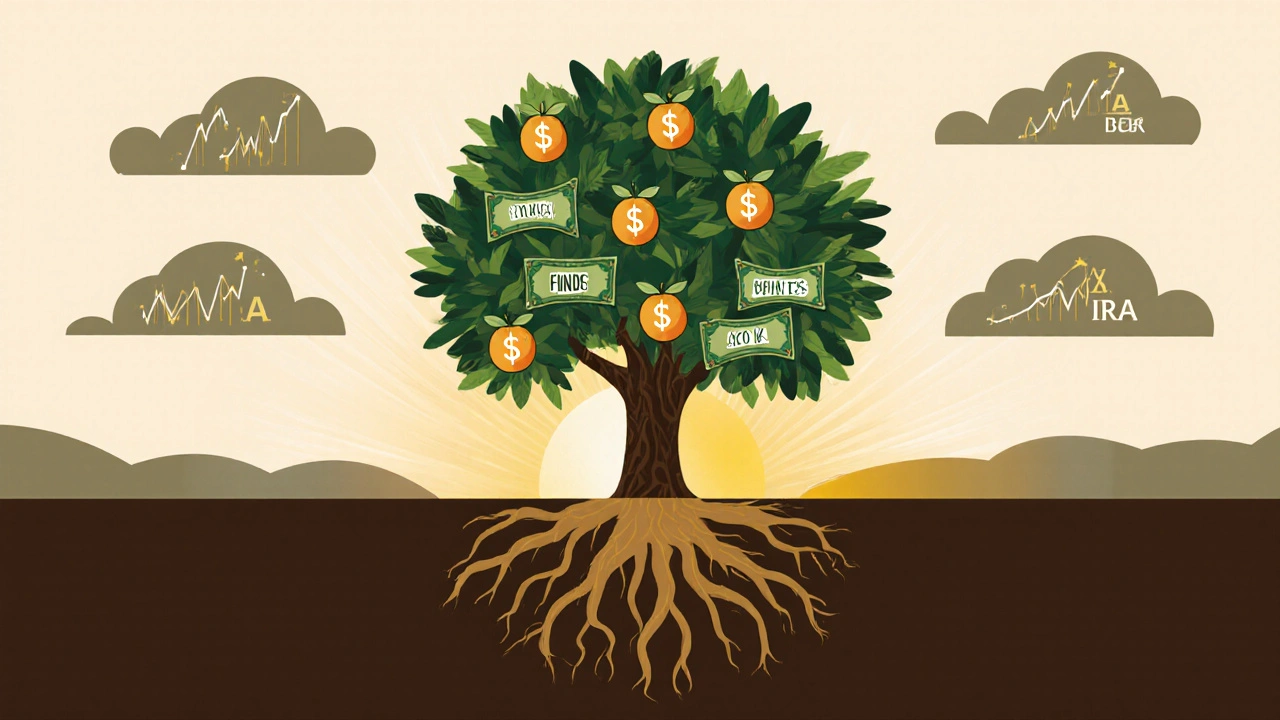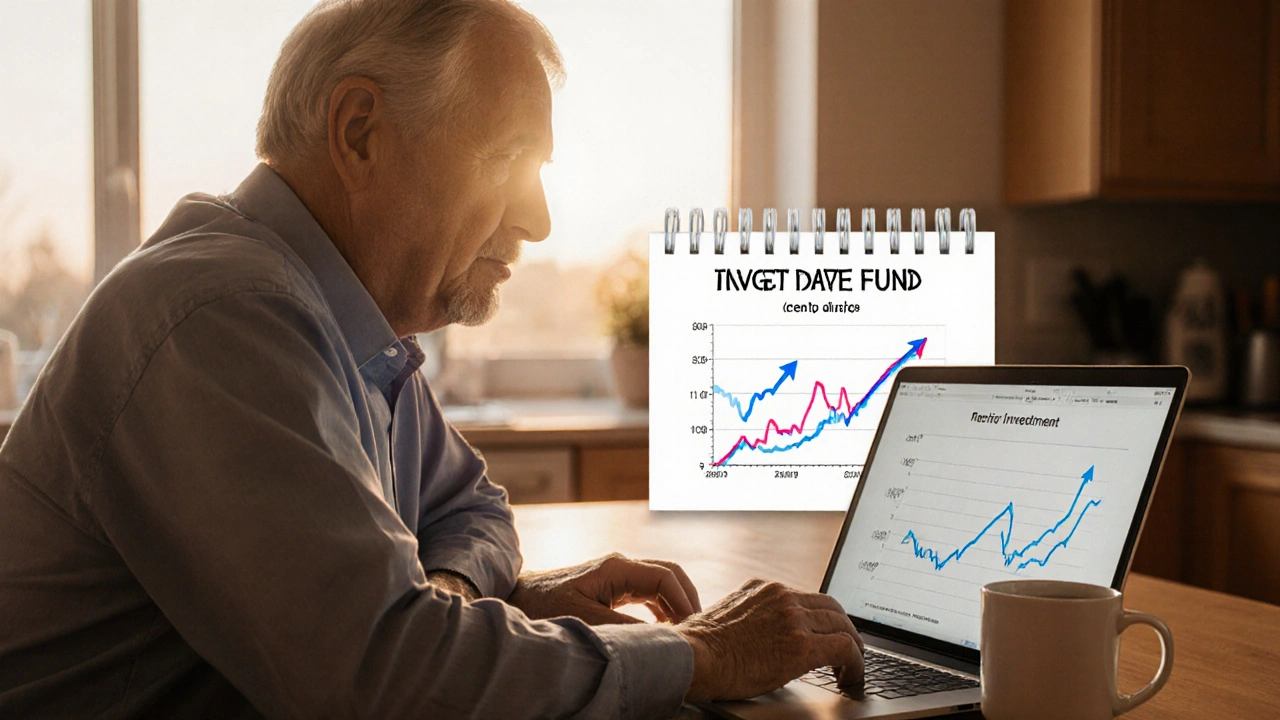Most people think retirement means stopping work. But the real goal? Having enough money to live how you want - without worrying about bills, medical costs, or running out. And the only reliable way to get there? Investments. Not lottery tickets. Not crypto hype. Not saving every spare dollar in a savings account earning 0.1% interest. Real, steady, compound-growing investments.
Why Saving Alone Won’t Get You There
You hear it all the time: "Save 10% of your income." Sounds smart, right? But if you make $60,000 a year and save $6,000 annually for 30 years, you’ll have $180,000. That’s before inflation. After inflation? That’s about $90,000 in today’s dollars. Good for a vacation fund. Not enough to retire on.
Here’s the math that matters: If you invest that same $6,000 a year and earn an average of 7% annual return - which is realistic over decades with a balanced portfolio - you’ll end up with over $600,000. That’s more than triple. And if you start at 25 instead of 35? You could hit $1.1 million. That’s the power of time and compound growth.
What Kind of Investments Actually Work for Retirement?
Not every investment is built for retirement. You don’t need to pick stocks like a day trader. You need tools that grow slowly, reliably, and keep up with inflation. Here’s what works:
- Index funds - These track the whole market, like the S&P 500. They cost next to nothing to own, and historically return about 7-10% a year over long periods. Vanguard’s VFIAX is one of the most popular. Over 30 years, $500 a month in this fund grows to nearly $700,000.
- Target-date funds - These are retirement funds that automatically adjust risk as you get older. If you plan to retire in 2045, you buy a 2045 fund. It starts aggressive, then shifts to bonds and safer assets as retirement nears. No thinking required.
- Real estate investment trusts (REITs) - These let you invest in apartments, warehouses, or shopping centers without buying property. They pay steady dividends and have historically returned 8-10% annually. Plus, they’re liquid - you can sell them like stocks.
- 401(k)s and IRAs - These aren’t investments themselves, but they’re the containers that make investing for retirement tax-efficient. If your employer matches your 401(k) contributions, you’re getting free money. Don’t walk away from that.
What doesn’t work? Individual stocks you picked because your cousin said they’d "double next year." Crypto. Gold bars in a safe. Collectible sneakers. These might make noise, but they don’t reliably build wealth over decades.
How Much Do You Actually Need to Retire?
There’s no magic number. But here’s a simple rule: Multiply your annual spending in retirement by 25. If you think you’ll need $50,000 a year to live, you need $1.25 million saved. Why 25? Because if you withdraw 4% a year - $50,000 from $1.25 million - your money should last 30+ years, even with inflation.
That number feels huge. But break it down. Saving $1,000 a month for 25 years at 7% return gets you $700,000. Add a 3% annual raise to your contributions? You’re at $1.1 million. You don’t need to save a million overnight. You just need to start, and keep going.

The Biggest Mistake People Make
It’s not losing money in the market. It’s not picking the wrong fund. It’s waiting.
People delay investing because they think they need more money, better knowledge, or the perfect moment. But the market doesn’t wait. Inflation doesn’t wait. Your body doesn’t wait.
One client I worked with - a teacher in Chicago - started investing $200 a month at age 42. She was terrified. She didn’t know what an ETF was. She just opened a Roth IRA and set up auto-investing into a target-date fund. Ten years later, she had $78,000. Not a fortune. But enough to cover her medical bills and travel without touching Social Security.
She didn’t get rich. She got secure. That’s the goal.
Where to Start - Right Now
You don’t need a financial advisor to begin. You don’t need a $10,000 bonus. You just need to take one step.
- Check if your employer offers a 401(k) with a match. If yes, contribute at least enough to get the full match. That’s instant 100% return.
- Open a Roth IRA at Fidelity, Vanguard, or Charles Schwab. These are free to open. No minimums.
- Pick one target-date fund for your retirement year. Set up automatic transfers of $50, $100, or $200 every payday.
- Ignore the news. Don’t check your balance every day. Let it grow.
That’s it. No complex formulas. No stock-picking. Just consistent, boring, reliable investing.

What Happens If You Start Late?
You still win. You just have to save more.
If you’re 50 and have nothing saved, you’ll need to put away $1,500 a month for 15 years at 6% return to reach $400,000. That’s tough, but possible. You’ll need to cut expenses, work longer, or downsize. But you can still build a retirement that lets you sleep at night.
People who start at 55 with $10,000 saved and add $800 a month will have $250,000 by 65. That’s enough to cover basic needs with Social Security. Not luxury. But dignity.
Investments Are About Freedom, Not Riches
Retirement isn’t about buying a yacht or flying to Bali every winter. It’s about choosing how you spend your days. Waking up without checking your bank account. Saying no to a job you hate. Helping your kids without draining your savings. Taking a long walk because you want to, not because you can’t afford a doctor’s visit.
Investments are the quiet, daily act that makes that freedom possible. You don’t need to be rich. You just need to be consistent. And start now.
What’s the best investment for retirement?
There’s no single "best" investment, but for most people, low-cost index funds or target-date funds in a 401(k) or Roth IRA are the most reliable. They offer broad market exposure, low fees, and automatic rebalancing. Over 30 years, these typically return 7-8% annually after inflation.
Can I retire on Social Security alone?
Social Security replaces about 40% of your pre-retirement income on average - not enough for most lifestyles. In 2025, the average monthly benefit is $1,900. That’s $22,800 a year. If your housing, healthcare, and food cost more than that - and they will - you’ll need savings to cover the gap.
How much should I invest each month?
Aim for at least 15% of your gross income. If you make $50,000 a year, that’s $6,250 a year, or about $520 a month. If that’s too much, start with what you can - even $50 a month. The key is to start and increase it over time as your income grows.
Should I invest in real estate for retirement?
Real estate can be part of a retirement plan, but it’s not for everyone. Direct property ownership requires management, maintenance, and tenant risk. REITs are a simpler alternative - they let you invest in real estate like a stock, with dividends and less hassle. Most people do better with diversified index funds first.
Is it too late to start investing if I’m over 50?
It’s never too late. If you’re 55 with nothing saved, you can still build a solid retirement by saving aggressively - $1,000 to $1,500 a month - and working a few extra years. Even $200,000 saved by 65 can provide $8,000 to $10,000 a year in safe withdrawals, plus Social Security. That’s enough to avoid poverty.
What’s the biggest risk in retirement investing?
The biggest risk isn’t market crashes - those happen, and you recover. The real risk is not investing at all, or waiting too long. Inflation slowly eats away at cash savings. Missing out on compound growth means you’ll need to save much more later. Time is your greatest ally - and your biggest enemy if you ignore it.



Mark Nitka
November 25, 2025 AT 03:20Man, I wish I’d read this when I was 22. I wasted five years thinking I needed to ‘save every penny’ before investing. Turned out my savings account was just losing money to inflation. Started putting $300/month into a target-date fund at 27 - now I’ve got over $200k. No fancy tricks. Just time and consistency. Don’t overthink it.